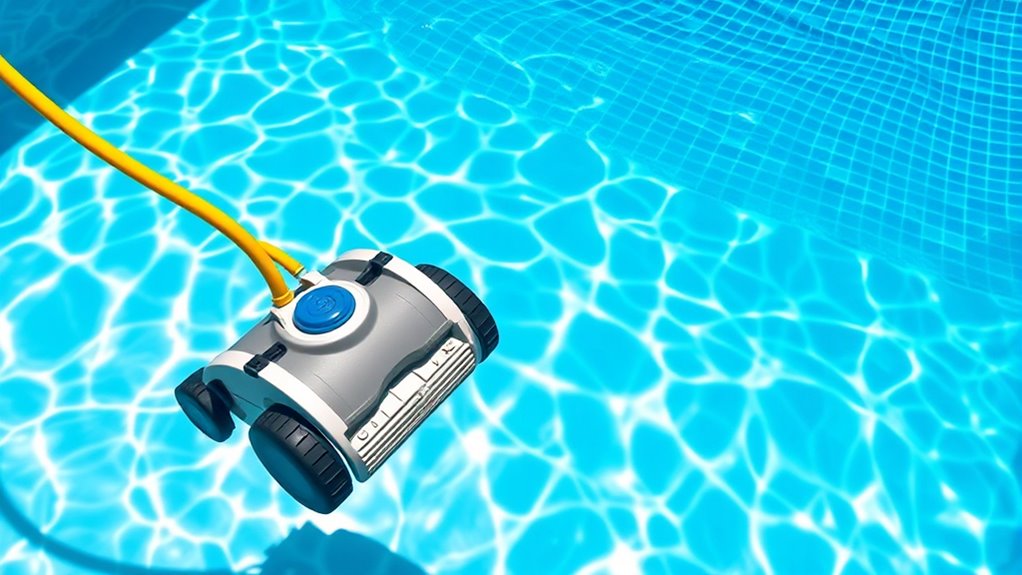Using suction pool cleaners in above-ground pools is usually straightforward, as their simple design suits smaller, easier-to-access pools. In-ground pools may require more setup, attention to plumbing, and proper hose placement for effective cleaning. While suction cleaners can work well for both, in-ground pools often demand higher power and maintenance, especially for complex shapes or larger sizes. To get the best results tailored to your pool type, explore the details ahead.
Key Takeaways
- Suction cleaners are generally compatible with both above-ground and in-ground pools, but installation and hose length may vary.
- In-ground pools often require stronger suction power and strategic fittings due to complex plumbing and surface materials.
- Above-ground pools typically offer easier access, simpler setup, and lower costs for using suction cleaners.
- Proper chemical balance and filter maintenance are essential for optimal suction cleaner performance in both pool types.
- Heavy debris or irregular shapes may limit cleaning effectiveness, prompting consideration of robotic or pressure-side cleaners for larger or complex pools.
How Suction Pool Cleaners Operate in Different Pool Types
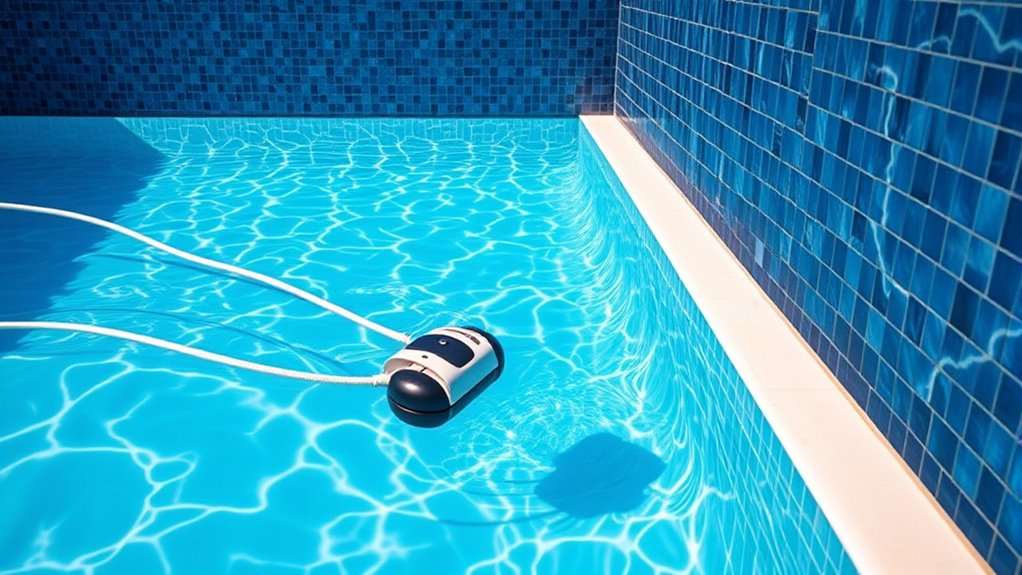
Suction pool cleaners work differently depending on the type of pool you have. If your pool is made of vinyl, fiberglass, or concrete, the pool material influences how the cleaner operates. For example, rougher surfaces like concrete may require more powerful suction to pick up debris effectively, while smoother surfaces such as fiberglass can let cleaners glide easily. Your user experience also varies; with the right setup, cleaning becomes more efficient and less frustrating. In-ground pools often have more complex plumbing, which can affect suction strength and coverage, whereas above-ground pools usually provide easier access. Understanding your pool’s material helps you select a cleaner that maximizes performance and simplifies maintenance, making your cleaning routine smoother and more effective. Additionally, the types of debris your pool accumulates can influence the choice of cleaner and its efficiency.
Compatibility of Suction Cleaners With Above-Ground Pools

Above-ground pools are generally compatible with suction pool cleaners, making them a convenient choice for homeowners seeking easy maintenance. The pool material, usually vinyl or lightweight resin, doesn’t pose significant issues for most suction cleaners. Additionally, the pool design—often featuring smooth, simple surfaces and straightforward shapes—allows the cleaner to move efficiently without frequent snagging or obstructions. Since above-ground pools tend to have fewer complicated features like built-in stairs or intricate corners, suction cleaners can effectively cover the entire surface. Proper fitting hoses and attachments are essential to ensure optimal cleaning performance, especially considering the material composition of the pool. Furthermore, the design simplicity of above-ground pools minimizes the risk of the cleaner getting stuck or tangled. Regularly checking and maintaining the hose connections can improve cleaning efficiency and prolong the lifespan of the equipment. Incorporating the right technology can also enhance overall cleaning effectiveness. Additionally, understanding the pool surface type helps in selecting the most suitable suction cleaner for your needs. Overall, most suction pool cleaners work well with typical above-ground pools, providing a hassle-free cleaning experience.
Effectiveness of Suction Cleaners in In-Ground Pools
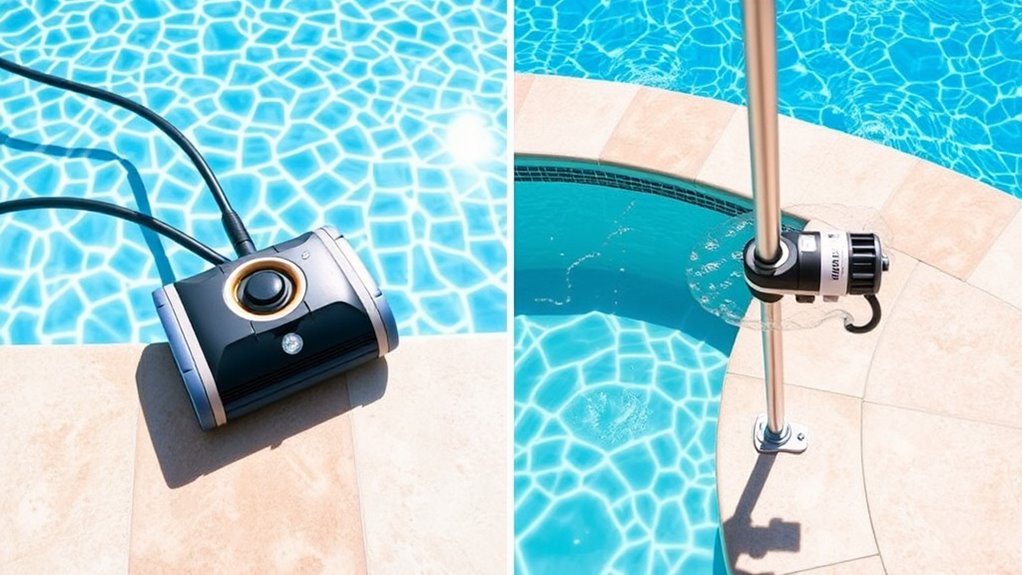
Suction cleaners can effectively deep clean your in-ground pool, reaching areas that manual skimming might miss. Their obstacle navigation helps them cover most surfaces efficiently, even around corners and steps. However, their performance depends on the model’s ability to handle complex pool layouts and debris. Additionally, high contrast ratios enhance the visibility of the cleaner’s coverage, ensuring more thorough cleaning results. The integration of automation technology further improves their effectiveness in navigating intricate pool designs. Proper maintenance of these devices also plays a crucial role in maintaining their cleaning efficiency over time. Moreover, understanding how pool layout complexities influence cleaner performance can help you select the most suitable model for your specific pool.
Deep Cleaning Capabilities
Although some may doubt their ability to handle deep cleaning tasks, suction pool cleaners are highly effective at maintaining in-ground pools. Their cleaning algorithms are designed to target dirt and debris across all pool areas, ensuring thorough coverage. With strong suction power, these cleaners can lift even stubborn particles from the pool floor and walls. The combination of efficient cleaning algorithms and robust suction allows for extensive cleaning that keeps your pool pristine. You’ll find that suction pool cleaners consistently remove dirt deep within the surface, reducing the need for manual scrubbing. Their ability to reach difficult spots makes them ideal for all-encompassing deep cleaning, giving you confidence that your in-ground pool stays sparkling clean and hygienic. Additionally, their capability to operate effectively in remote or hard-to-access areas makes them a versatile choice for comprehensive pool maintenance. Proper installation and maintenance are essential to ensure optimal performance and longevity of the cleaner, especially considering the importance of regular upkeep in maintaining their effectiveness.
Obstacle Navigation Efficiency
Efficient obstacle navigation is key to a suction pool cleaner’s overall performance in in-ground pools. Your cleaner relies on advanced navigation algorithms to map out the pool’s layout and avoid obstacles effectively. Sensor technologies, such as infrared or ultrasonic sensors, detect objects and boundaries in real-time, allowing the cleaner to adjust its path seamlessly. These systems help prevent the cleaner from getting stuck or missing areas, ensuring thorough coverage. In in-ground pools with complex shapes or many obstacles, superior navigation algorithms and sensors improve cleaning efficiency markedly. By accurately sensing and responding to the environment, your suction cleaner can maneuver around ladders, drains, and other fixtures with ease, delivering more consistent and complete cleaning results. Incorporating advanced technology into your cleaner’s design further enhances obstacle detection and navigation capabilities.
Installation and Setup Considerations for Each Pool Type
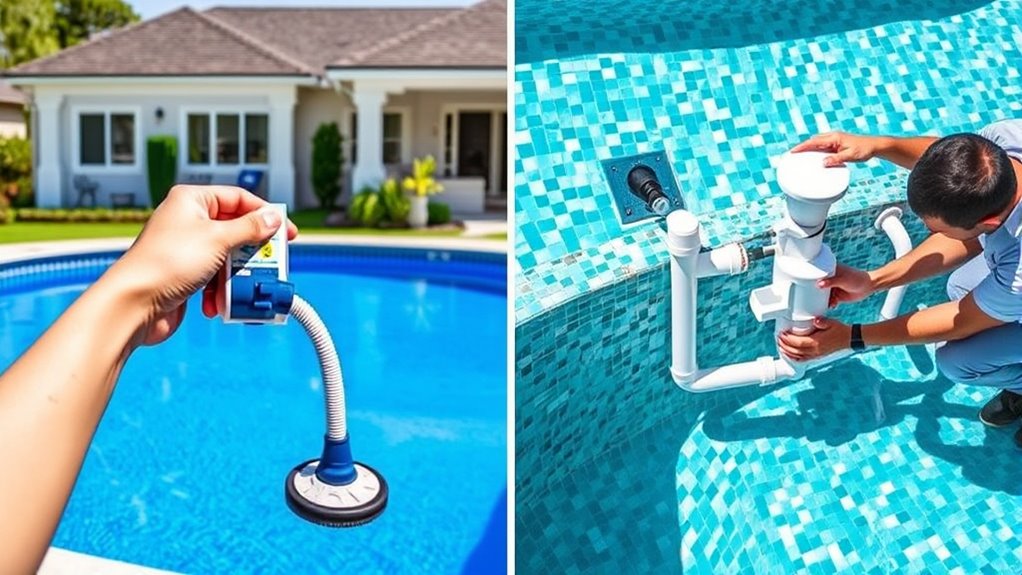
When setting up a suction pool cleaner, it’s important to take into account the specific type of pool you have, as each requires different installation steps. For above-ground pools, ensure the hose length matches the pool’s size and secure the skimmer or dedicated suction port. In-ground pools often need fittings installed at strategic points, considering the pool material and color, which can affect visibility and cleaning efficiency. Proper tuning of the pool’s filtration system can also improve the effectiveness of the cleaner and overall maintenance. Additionally, understanding the technology in energy distribution can help optimize the operation of pool equipment, leading to better energy efficiency. Recognizing the importance of proper storage of equipment can prevent damage and ensure longevity of the cleaning tools. Incorporating pool design considerations can further enhance cleaning performance and ease of installation. Emphasizing a creative approach to troubleshooting installation issues can foster more innovative solutions for complex setups.
Maintenance and Troubleshooting Tips for Optimal Performance
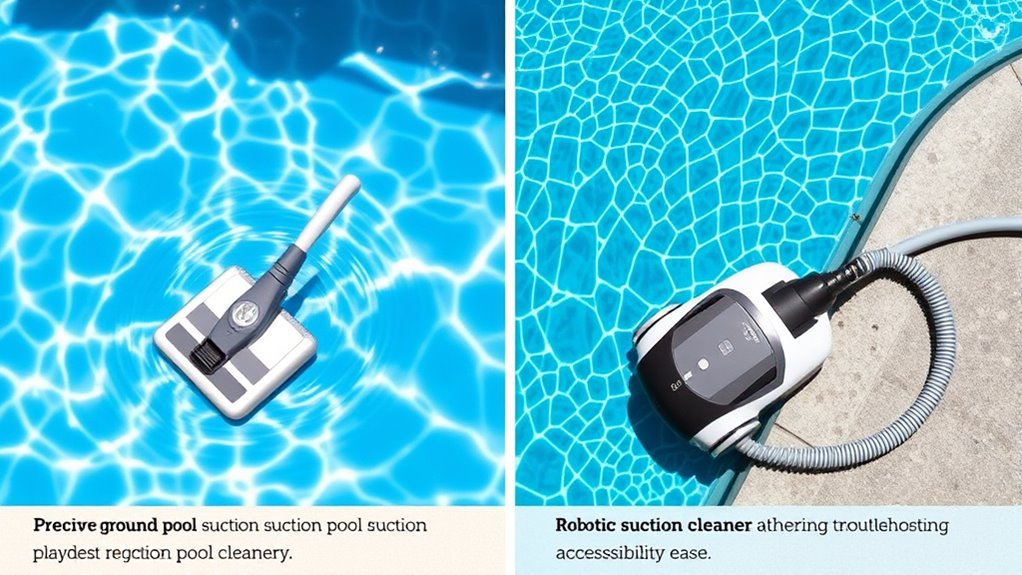
Regular maintenance and troubleshooting are key to keeping your suction pool cleaner performing at its best. Start by regularly checking and balancing your pool chemical levels to prevent algae growth and maintain water clarity. Proper pool chemical management guarantees your cleaner operates efficiently and reduces wear. Additionally, inspect and clean the filter regularly to prevent clogs that can hinder suction power. If you notice your cleaner isn’t picking up debris effectively, verify the hose connections and ensure no leaks are present. Clear any blockages in the intake or brushes, and replace parts if necessary. Keeping these components in top shape minimizes downtime and extends your cleaner’s lifespan. Regularly monitoring suction power and ensuring it remains consistent can help maintain optimal cleaning performance. Also, consider inspecting the electric motor periodically to prevent unexpected failures, especially if your pool cleaner is a more advanced model. Keeping these components in top shape minimizes downtime and extends your cleaner’s lifespan. Consistent filter maintenance and chemical checks will keep your pool cleaner running smoothly and efficiently.
Cost Differences Between Cleaning Systems for Above-Ground and In-Ground Pools
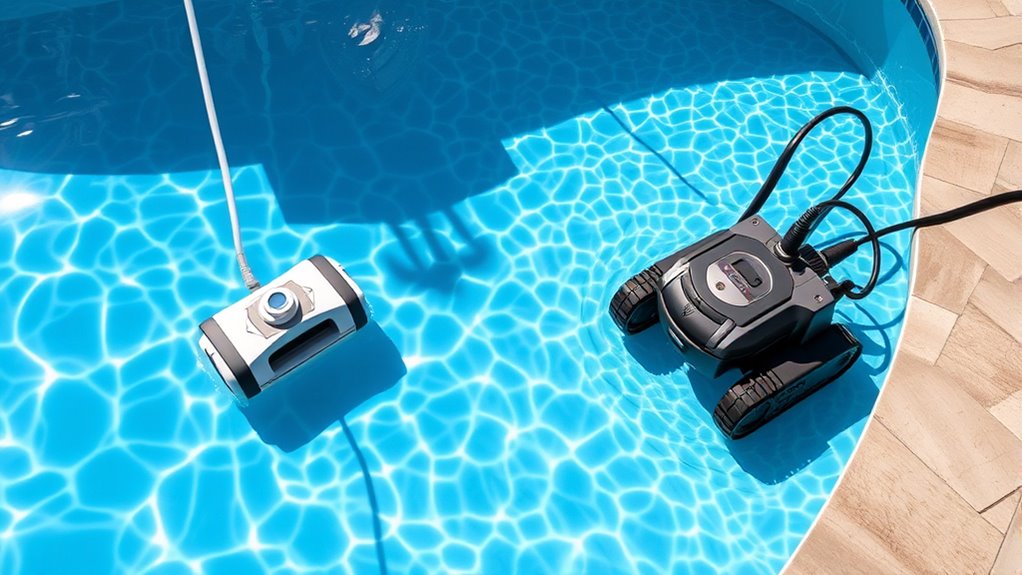
The cost of cleaning systems varies considerably between above-ground and in-ground pools, primarily due to differences in pool size, complexity, and installation requirements. You’ll notice that pricing models differ markedly, with above-ground systems generally costing less upfront but offering limited warranty coverage. In contrast, in-ground pool cleaners tend to have higher initial prices but often include more extensive warranty options, protecting your investment over time.
- Above-ground cleaners often feature simpler designs and lower purchase prices
- In-ground systems usually come with advanced features, increasing costs
- Warranty coverage varies, with in-ground models typically offering longer-term protection
- Installation costs can add considerably to in-ground cleaning systems
- Long-term maintenance expenses are influenced by the quality and warranty of the cleaner
Best Practices for Using Suction Cleaners in Above-Ground Pools
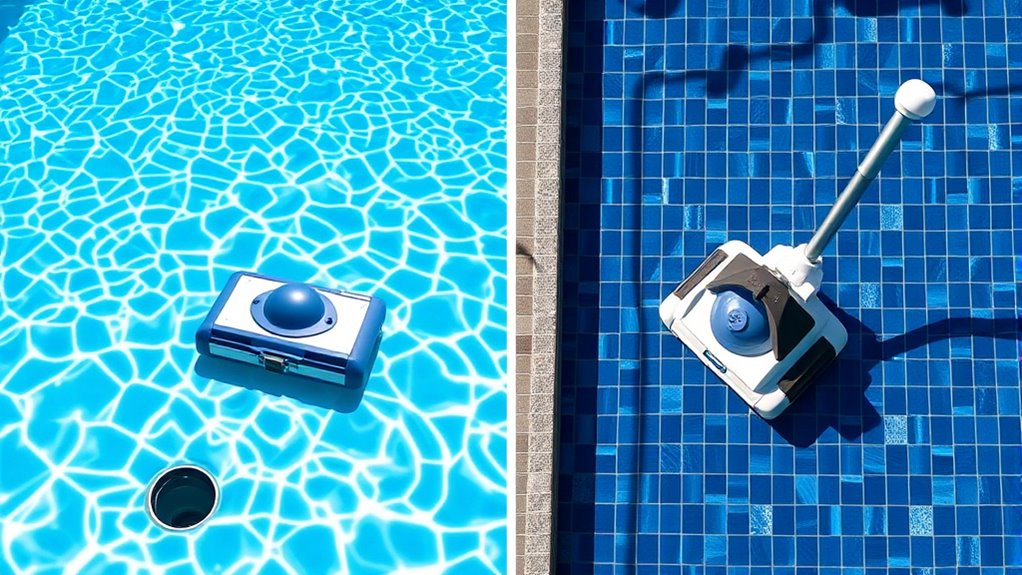
To get the most effective cleaning from your above-ground pool’s suction cleaner, it’s crucial to follow best practices for setup and operation. Ensure your pool’s chemical balance is correct before cleaning to prevent debris buildup and protect your equipment. Regular seasonal maintenance, like cleaning filters and inspecting hoses, keeps the cleaner functioning at its best. Properly position the cleaner in the pool, avoiding areas with obstacles or strong currents. Adjust the flow rate to match your pool size for thorough coverage.
| Step | Action | Tip |
|---|---|---|
| Check chemical levels | Balance pH, alkalinity, and sanitizer | Prevent algae and debris buildup |
| Clean filters | Remove debris from filter system | Maintain suction power |
| Inspect hoses | Look for leaks or blockages | Ensure smooth operation |
| Seasonal maintenance | Store or service cleaner during off-season | Extend lifespan |
Enhancing Cleaning Efficiency in In-Ground Pools
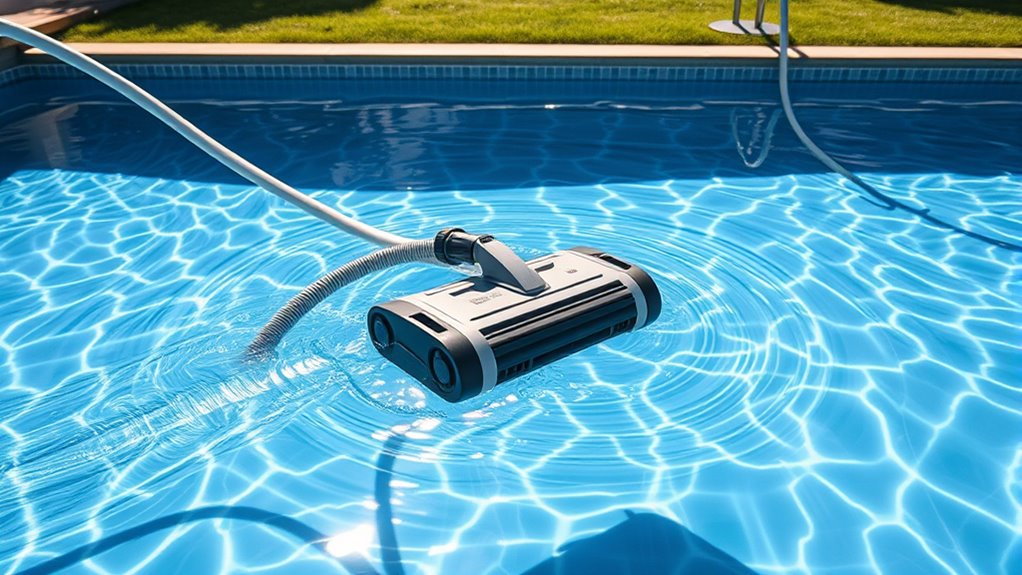
Enhancing cleaning efficiency in in-ground pools requires careful attention to equipment setup and maintenance. Properly balanced chemicals prevent algae buildup, making suction cleaning more effective. Ensure your pool lighting doesn’t cast shadows or obscure debris, simplifying the cleaning process. Regularly check and clean your skimmer baskets to keep water flow ideal. Maintain correct suction levels to avoid missed spots. Adjust pool lighting to improve visibility, allowing you to spot debris quickly. Proper chemical balancing reduces membrane wear and keeps the pool surface smooth, aiding the cleaner’s efficiency. Additionally, clean filters frequently to prevent clogging. Combining these steps ensures your suction pool cleaner operates at peak performance, reducing cleaning time and improving water clarity.
Limitations and When to Consider Alternative Cleaning Options
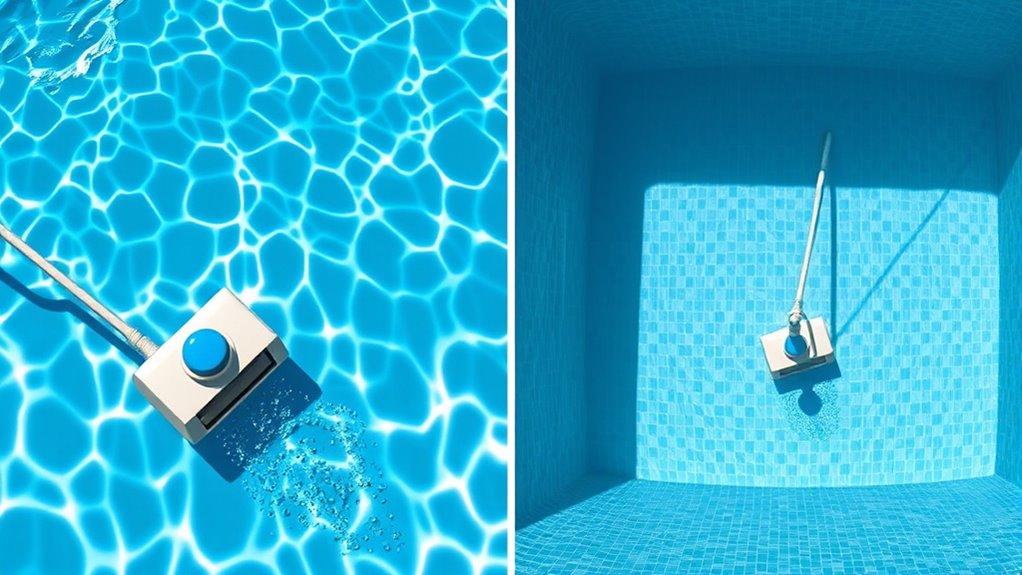
Suction pool cleaners have their limits, especially with larger pools or those with many obstructions. If your pool is big or filled with leaves and debris, the cleaner may struggle to maintain. In these cases, you should consider other options to ensure thorough cleaning.
Pool Size Constraints
While suction pool cleaners are effective for many pools, their performance can be limited by the size of your pool. Larger pools may hinder thorough cleaning coverage, making it difficult to reach every corner efficiently. If your pool exceeds the cleaner’s designed capacity, you might notice incomplete cleaning cycles or longer times to finish. Consider alternative options if:
- The pool size is too large for the cleaner’s suction power
- You need exhaustive cleaning coverage in a short time
- The cleaner struggles to maintain consistent movement
- The pool layout is complex or irregular
- You want a more automated, less hands-on solution for bigger pools
In such cases, upgrading to a robotic cleaner or a pressure-side cleaner might provide better results, saving you time and ensuring your pool stays pristine.
Obstructions and Debris
Obstructions and debris can considerably impair the efficiency of your suction pool cleaner. Large leaves, twigs, or toys can clog the intake or cause the cleaner to stall. Additionally, an unbalanced pool chemical level can lead to algae buildup, increasing debris and making cleaning more challenging. Water temperature also plays a role; warmer water promotes algae growth and debris accumulation, which can overwhelm your cleaner. When obstructions are frequent or debris is heavy, consider alternative cleaning options like robotic cleaners or manual skimming. Regularly check for obstructions, maintain proper pool chemical balance, and adjust cleaning frequency based on water temperature. Doing so helps ensure your suction cleaner operates efficiently and keeps your pool crystal clear.
Frequently Asked Questions
Can Suction Pool Cleaners Be Used With Robotic or Pressure-Side Cleaners?
You can use suction pool cleaners alongside robotic or pressure-side cleaners, but check their compatibility first. Some robotic cleaners aren’t designed for suction ports, so verify robot compatibility with your existing system. For maintenance tips, regularly clean filters and check hoses to guarantee peak performance. Combining these cleaners can give you a cleaner pool, but always follow manufacturer instructions to avoid damage and keep everything working smoothly.
How Do Pool Size and Shape Affect Suction Cleaner Performance?
Like a master artist shaping their canvas, your pool’s size and shape influence suction cleaner performance. Larger pools demand more power, while complex shapes and tight corners can challenge navigation. Small, simple pools allow for efficient cleaning, but irregular shapes may leave debris untouched. Consider pool dimensions and shape considerations to select the right cleaner, ensuring your pool stays pristine no matter its size or design.
Are There Safety Concerns When Using Suction Cleaners in Different Pools?
When using suction pool cleaners, safety concerns like electrical safety are essential. Make certain your cleaner is properly grounded and avoid using it if cords or connections are damaged. Check pool chemical compatibility to prevent corrosion or damage to the cleaner. Always follow manufacturer instructions, especially in pools with high chemical levels, and regularly inspect equipment. Staying cautious helps prevent accidents and prolongs your cleaner’s lifespan.
What Is the Typical Lifespan of a Suction Pool Cleaner?
Did you know that a well-maintained suction pool cleaner can last 5 to 8 years? The lifespan depends on how often you perform maintenance, like cleaning filters and checking hoses. Regular upkeep reduces wear and tear, saving you money on replacement costs. If you neglect maintenance, the cleaner’s lifespan drops markedly. So, stay consistent with care, and your cleaner will serve you well for many seasons.
Do Suction Cleaners Require Special Pool Accessories or Modifications?
You don’t need special accessories or major modifications for your suction pool cleaner. Just verify your pool’s filter system is compatible, as some cleaners work better with specific filter types. Check installation requirements carefully; most models simply connect to your skimmer or dedicated suction line without extra tools. By confirming pool filter compatibility and following the installation instructions, you’ll keep your cleaner working efficiently without hassle.
Conclusion
No matter your pool type, choosing the right suction cleaner ensures a sparkling swim. Above-ground pools are simpler to maintain, just like a trusty steed, while in-ground pools demand more finesse and patience. Remember, even the most advanced gadgets can’t substitute regular upkeep. So, stay vigilant, and don’t rely solely on your robot like a knight in shining armor—sometimes, old-school care wins the day. Keep at it, and your pool will be the talk of the town!
